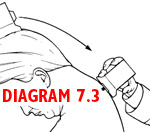REVIEW
IN MEDIAS RES ALL OVER AGAIN
Vain Art of the Fugue, Dumitru Tsepeneag
(Translated from the Romanian by Patrick Camiller), Dalkey Archive,
2007
I read
most of Dumitru Tsepeneag's Vain Art of the Fugue on the bus
to and from work, which might be the ideal way to experience this gordian
little novel, because that's where most of it takes place—on a bus,
repeatedly. Repetition is the principal characteristic of the book (Tsepeneag's
first to be translated into English), in which the same episode is retold
over and over, fugue-like, but never in quite the same way.
A man carrying a bunch of flowers
runs to catch a bus, having just left his lover (wife?) at home, barely
makes it before the bus departs, and urges the driver to hurry because
he's late to meet another woman at the train station.
Now repeat, only this time he misses
the bus, or trips over a dog, or bumps into a bicyclist, or a bevy of
bicyclists, or appears from the point of view of the bicyclist, or from
two different points of view simultaneously, or forget all the buses and
bicycles and segue to the train, which is just now pulling into the station,
or leaving it, or stalled on the tracks outside town.
You get the picture. In one version,
the man challenges the bus driver to a race, sprinting down the sidewalk
to the ridiculous cheers of onlookers, while the bus recklessly careens
past scheduled stops and traffic signals. In another, he never makes it
out of the house, and instead lies in bed daydreaming of a long-ago day
at the beach when he enjoyed an anonymous fling. Tsepeneag doesn't linger
in these parallel universes. Just when you feel like you're getting somewhere,
the story loops back and starts again.
Sound monotonous? Occasionally it
is. (Another reason why it makes for easy bus reading—there's never
any danger of losing your place.) But it's also surprising what happens
after the fourth or fifth variation, as seemingly minor details—a
bag of fish, a pig being slaughtered, a few snippets of dialogue—begin
to take on almost symbolic importance each time they appear somewhere
else. In the end, what started out as a simple sequence of events has
become the literary equivalent of a Philip Glass melody—not so much
a plot, but a richly resonant pattern of elements drilled into your brain.
(In a particularly sly wink to the
reader, Tsepeneag has several characters debate Zeno's paradox of impossible
locomotion, reminding us that all this rising action is going, literally,
nowhere.)
Not all of the renditions work equally
well. A few of the more frivolous retellings come off as self-indulgent,
and the longer they go on, the less funny they get. It's also tempting
at times to dismiss the whole project as a writing exercise, and from
that perspective the vanity in the title seems like a bad joke. But what
ultimately saves the book from being a mere thought experiment is Tsepeneag's
starkly beautiful writing. By the novel's end, we may not have covered
any appreciable distance, but we've been swept along the entire time.
[AW]
